05: Neutral Atom Simulator (Worked Solution)
Contents
05: Neutral Atom Simulator (Worked Solution)#
This is one possible way to implement a simple circuit simulator for an array of neutral atoms. It is not the only way or even necessarily “the best way”.
The implementation is intended to be simple and readable, while still implementing a set of universal gates.
Imports#
import qutip
import numpy as np
%matplotlib inline
import matplotlib.pyplot as plt
Helper functions#
The computational_basis_blochs function makes plotting the outcomes of circuits more convenient. It is not part of the simulator, but it is very useful. It keeps the notebook cells readable, and allows one to focus on the task at hand, rather than worrying about the details of sub-tasks like plotting.
Note that one cannot represent the complete state of N-qubits or N-qutrits on N Bloch spheres – separating the state loses information about entanglement between them. Also note that the fully mixed state for one qubit (i.e. a 50/50 mixture of the |0> and |1> states) is rendered at the origin of the Bloch sphere.
def computational_basis_blochs(states, colors="r", view=(60, 30)):
""" Render each qutrit separately on a Bloch sphere, showing only the computational basis states,
i.e. the states |0> and |1>, tracing out the Rydberg interaction state |2>.
Parameters
----------
states : list of Qobj, or a single Qobj
The N-qutrit states to display. Each qutrit is plotted separately on the Bloch sphere
by first tracing out the others and then dropping the parts of the density matrix that
depend on the |2> state.
colors : list or str of colors, default "r"
Specifies the color to use when displaying each of the N-qutrits. If the number of qutrits
is greater than the number of colors, the function cycles through the list of colors. The
default, "r", shows all qutrits in red.
view : tuple of two floats, default (60, 30)
The angle to view the bloch sphere from.
"""
b = qutip.Bloch()
b.view = list(view)
b.vector_color = []
if isinstance(states, qutip.Qobj):
states = [states]
if states:
for i in range(len(states[0].dims[0])):
c = colors[i % len(colors)]
b.vector_color.extend([c] * len(states))
for s, alpha in zip(states, np.linspace(0.5, 1.0, len(states))):
rho_qutrit_i = qutip.ptrace(s, i)
rho_qubit_i = qutip.Qobj(rho_qutrit_i.full()[:2, :2], dims=[[2], [2]])
b.add_states(rho_qubit_i, alpha=alpha)
b.show()
Implementation#
We implement the simulator as a single class. This keeps the implementation all neatly in one place.
Here is an overview of the methods of the class to help in understanding it:
__init__:This sets up various constants, such as the qutrit basis elements, the qubit Pauli operators, the Rydberg interaction Hamiltonian, the solver options. It also sets up an empty list of pulses and initializes the end time of the last pulse,
t, to0.state:A convenience function that returns a system state based on a string describing the state of each qubit. For example,
circuit.state("01")returns|0> ⊗ |1>._place_op:Expands an operator on a single atom to an operator on the full state of all atoms, but tensoring the operation with appropriate copies of the identity. For example,
_place_op(1, op)returnsI ⊗ op._add_pulse:Adds a new pulse to the list of pulses, starting at the end of the last pulses, i.e.
self.t, and lasting for durationdt. The list of pulses is added to the constant Hamiltonian when the circuit is run.rx,ry,rz,h:Implementations of the single qubit gates. Each of these adds a list of pulses that act on the specified qubit / atom.
cz,cnot:Implementations of the two qubit gates. These add pulses that act on each of the two qubits, but also rely on the Rydberg interaction defined by the constant part of the Hamiltonian for the blockade interaction between the two qubits. Note that if the atoms are too far apart, there will be no Rydberg interaction and these two qubit gates will not function as expected!
run:Run the circut and return the results from the QuTiP solver. By default it uses a
tlistofrange(0, t, t * 20)wheretis the end of the last pulse, but one may specify a customtlistor adjust the factor of20by changingstep_rate.
class NeutralAtomCircuit:
""" A neutral atom circuit laser pulse simulator.
Parameters
----------
atoms : ndarray or list of (x, y) coordinate tuples
The 2-D coordinates of each neutral atom. For example, [(1, 0), (0, 1)]. The co-ordinates
are used to calculate the Rydberg coupling coefficient -- i.e. 1 / R**6 where R is the
distance between atoms. Distances ~1 give strong coupling. Distances >> 1 give very weak couplings.
"""
def __init__(self, atoms):
self.n = len(atoms)
self.atoms = np.array(atoms)
self.pulses = []
self.t = 0
# calculate pair-wise distances and couplings:
# The actual value of C^6 is 862690 * 2 * np.pi (in units of MHz * μm^6) but that makes solving
# for the dynamics slow, so we use something a bit less:
self._c6 = 10_000
self._r_distances = np.linalg.norm(self.atoms[:, None, :] - self.atoms[None, :, :], axis=-1)
self._r_couplings = np.zeros_like(self._r_distances)
non_zero = self._r_distances != 0
self._r_couplings[non_zero] = self._c6 / (self._r_distances[non_zero] ** 6)
# qutrit basis elements:
self._a = a = qutip.basis(3, 0)
self._b = b = qutip.basis(3, 1)
self._r = r = qutip.basis(3, 2)
# qutrit pauli matrixes on the computation basis, i.e. ab:
self._ab_sx = a * b.dag() + b * a.dag()
self._ab_sy = 1j * a * b.dag() - 1j * b * a.dag()
self._ab_sz = b * b.dag() - a * a.dag()
# qutrit sigmax matrix for the |a>, |r> basis:
self._ar_sx = a * r.dag() + r * a.dag()
# qutrit rydberg state occupation operator:
self._rr = r * r.dag()
# construct the time-independent part of the Hamiltonian (i.e. the Rydberg interactions):
self.H_rydberg = qutip.Qobj(dims=[[3] * self.n, [3] * self.n])
self.rr = rr = [
self._place_op(i, self._rr) for i in range(self.n)
]
for i in range(self.n):
for j in range(i + 1, self.n):
self.H_rydberg += self._r_couplings[i, j] * rr[i] * rr[j]
# solver options:
#
# setting a large nsteps just tells the solver we're happy for solving each timestep to take a long time
# setting max_step to less than the length of a pulse is extremely important -- if we don't the solver
# may skip a pulse entirely.
max_rydberg_eigenvalue = self.H_rydberg.eigenenergies(sort="high", eigvals=1)[0]
max_step = 0.1 # fraction of default pulse dt
self.options = qutip.Options(
nsteps=max(100 * max_rydberg_eigenvalue * max_step, 10_000),
max_step=max_step,
)
def state(self, s):
""" Return a ket corresponding to the given string description. For
example, `.state("01")` returns `|0> ⊗ |1>`. The characters supported are "0", "1", "+" and "-",
and each represents the expected corresponding basis element.
"""
states = []
for c in s:
if c == "0":
q = self._a
elif c == "1":
q = self._b
elif c == "+":
q = self._a + self._b
elif c == "-":
q = self._a - self._b
states.append(q.unit())
return qutip.tensor(states)
def _place_op(self, i, op):
ops = [qutip.qeye(3)] * self.n
ops[i] = op
return qutip.tensor(ops)
def _add_pulse(self, op, dt):
start = self.t
end = self.t + dt
self.t = end
f = lambda t, args: 1 if start <= t <= end else 0
self.pulses.append((op, f))
def rx(self, i, theta, dt=1):
""" Add a laser pulse that rotates qubit i an angle theta around the X axis. """
v = 0.5 * theta / dt
O = v
op = self._place_op(i, O * self._ab_sx)
self._add_pulse(op, dt)
def ry(self, i, theta, dt=1):
""" Add a laser pulse that rotates qubit i an angle theta around the Y axis. """
v = 0.5 * theta / dt
O = v
op = self._place_op(i, O * self._ab_sy)
self._add_pulse(op, dt)
def rz(self, i, theta, dt=1):
""" Add a laser pulse that rotates qubit i an angle theta around the Z axis. """
v = 0.5 * theta / dt
O = v
op = self._place_op(i, O * self._ab_sz)
self._add_pulse(op, dt)
def h(self, i):
""" Apply a hadamard gate to qubit i. """
self.rx(i, np.pi)
self.ry(i, np.pi / 2)
def cz(self, control, target, dt=1):
""" Add pulses that perform a controlled-Z phase flip operation on two qubits, assuming the
atoms are close enough for the Rydberg blockade to prevent both atoms entering the |r> state
simultaneously.
"""
v_c = 0.5 * np.pi / dt
O_c = v_c
v_t = 0.5 * 2 * np.pi / dt
O_t = v_t
op1 = self._place_op(control, O_c * self._ar_sx) # pi sx rotation from a -> r on control
op2 = self._place_op(target, O_t * self._ar_sx) # 2pi sx rotation from a -> r on target
op3 = self._place_op(control, O_c * self._ar_sx) # pi sx rotation from a -> r on control
self._add_pulse(op1, dt)
self._add_pulse(op2, dt)
self._add_pulse(op3, dt)
def cnot(self, control, target):
""" Apply a CNOT gate to a control and target qubit. """
# CNOT = (I ⊗ H) CZ (I ⊗ H)
self.h(target)
self.cz(control, target)
self.h(target)
def run(self, psi, tlist=None, step_rate=20):
""" Run the circuit. """
if isinstance(psi, str):
psi = self.state(psi)
if tlist is None:
tlist = np.linspace(0, self.t, int(self.t * step_rate) + 1)
if self.pulses:
H = qutip.QobjEvo([self.H_rydberg] + self.pulses)
else:
H = qutip.qeye([3] * self.n)
result = qutip.sesolve(H, psi, tlist=tlist, options=self.options)
return result
Example circuits#
Example 1: Pretty sequence of rotations (qubit 0)#
# Example 1: Pretty sequence of rotations (qubit 0)
atoms = [(0.5, 0), (0, 0.5)]
circuit = NeutralAtomCircuit(atoms)
circuit.rx(0, np.pi / 2)
circuit.rz(0, np.pi / 2)
circuit.ry(0, np.pi / 2)
result = circuit.run("00", step_rate=20)
# Show one Bloch sphere with initial and final states and
print("Duration of circuit (t):", circuit.t)
print("Number of pulses:", len(circuit.pulses))
computational_basis_blochs([result.states[0], result.states[-1]], "rb")
computational_basis_blochs(result.states, "rb")
Duration of circuit (t): 3
Number of pulses: 3
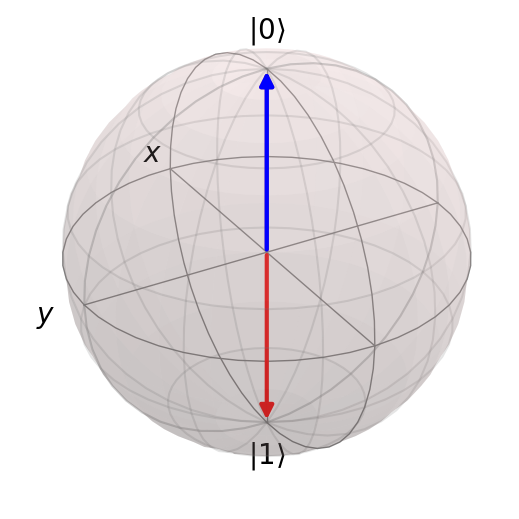
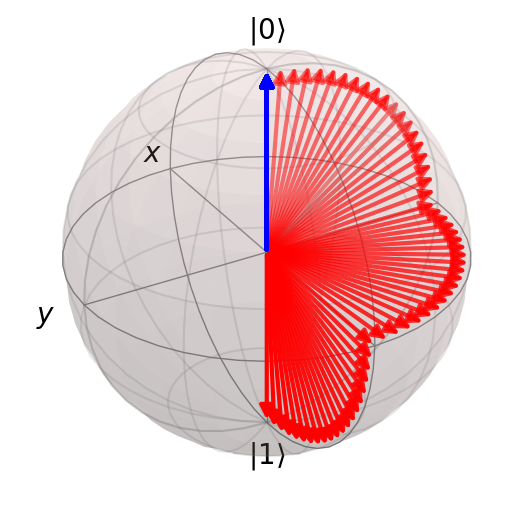
Example 2: Pretty sequence of rotations (qubit 1)#
# Example 2: Pretty sequence of rotations (qubit 1)
atoms = [(0.5, 0), (0, 0.5)]
circuit = NeutralAtomCircuit(atoms)
circuit.rx(1, np.pi / 2)
circuit.rz(1, np.pi / 2)
circuit.ry(1, np.pi / 2)
result = circuit.run("00", step_rate=20)
# Show one Bloch sphere with initial and final states and
print("Duration of circuit (t):", circuit.t)
print("Number of pulses:", len(circuit.pulses))
computational_basis_blochs([result.states[0], result.states[-1]], "rb")
computational_basis_blochs(result.states, "rb")
Duration of circuit (t): 3
Number of pulses: 3
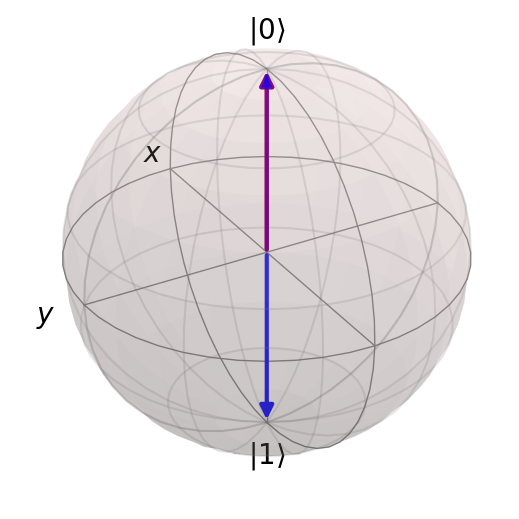
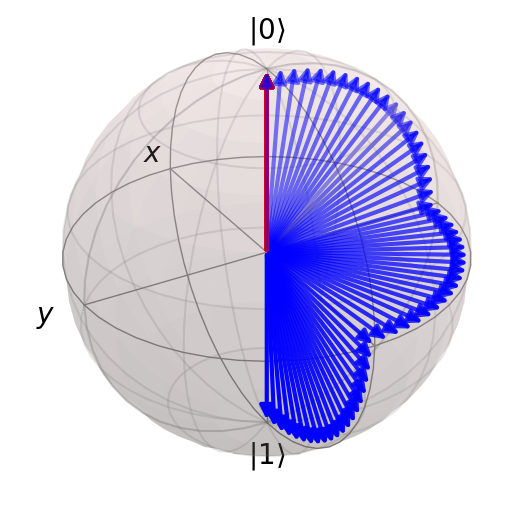
Example 3: Combine the previous two circuits#
# Example 3: Pretty sequence of rotations (qubit 0 & 1)
atoms = [(0.5, 0), (0, 0.5)]
circuit = NeutralAtomCircuit(atoms)
circuit.rx(0, np.pi / 2)
circuit.rz(0, np.pi / 2)
circuit.ry(0, np.pi / 2)
circuit.rx(1, np.pi / 2)
circuit.rz(1, np.pi / 2)
circuit.ry(1, np.pi / 2)
result = circuit.run("00", step_rate=20)
# Show one Bloch sphere with initial and final states and
print("Duration of circuit (t):", circuit.t)
print("Number of pulses:", len(circuit.pulses))
computational_basis_blochs([result.states[0], result.states[-1]], "rb")
computational_basis_blochs(result.states, "rb")
Duration of circuit (t): 6
Number of pulses: 6

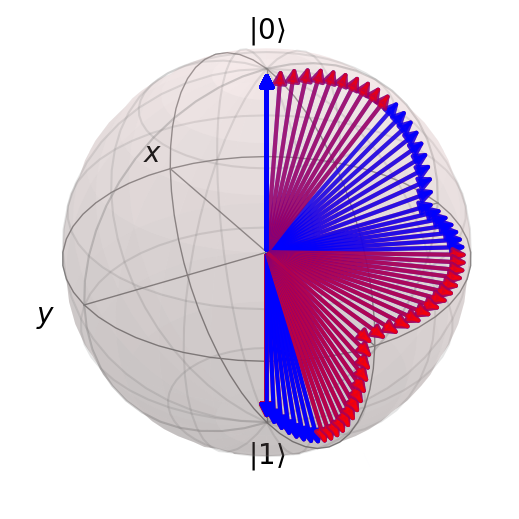
Example 4: Hadamard gate (qubit 0)#
# Example 4: Hadamard gate (qubit 0)
atoms = [(0.5, 0), (0, 0.5)]
circuit = NeutralAtomCircuit(atoms)
# H = Rx(pi) Ry(pi / 2):
circuit.rx(0, np.pi)
circuit.ry(0, np.pi / 2)
result = circuit.run("00", step_rate=20)
# Show one Bloch sphere with initial and final states and
print("Duration of circuit (t):", circuit.t)
print("Number of pulses:", len(circuit.pulses))
computational_basis_blochs([result.states[0], result.states[-1]], "rb")
computational_basis_blochs(result.states, "rb")
Duration of circuit (t): 2
Number of pulses: 2
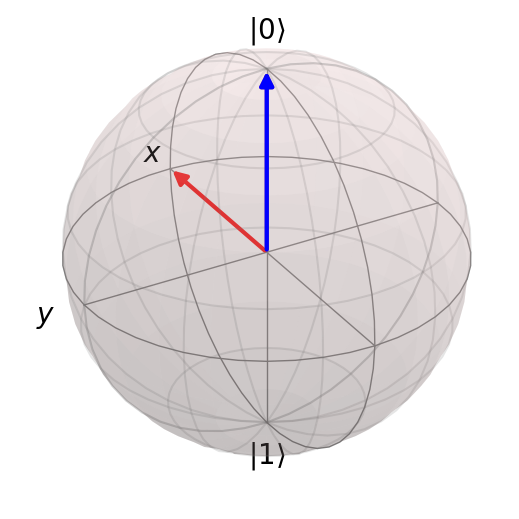
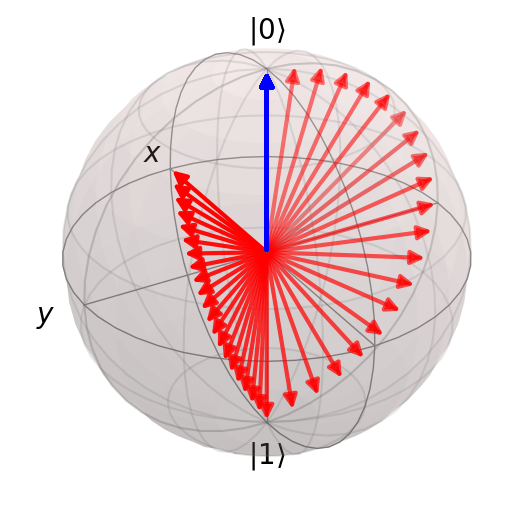
Example 5: CZ gate (control qubit 0, target qubit 1)#
# Example 5: CZ gate (control qubit 0, target qubit 1)
atoms = [(0.5, 0), (0, 0.5)]
circuit = NeutralAtomCircuit(atoms)
circuit.cz(0, 1)
result = circuit.run("0+", step_rate=20)
# Show one Bloch sphere with initial and final states and
print("Duration of circuit (t):", circuit.t)
print("Number of pulses:", len(circuit.pulses))
computational_basis_blochs([result.states[0], result.states[-1]], "rb")
computational_basis_blochs(result.states, "rb")
Duration of circuit (t): 3
Number of pulses: 3
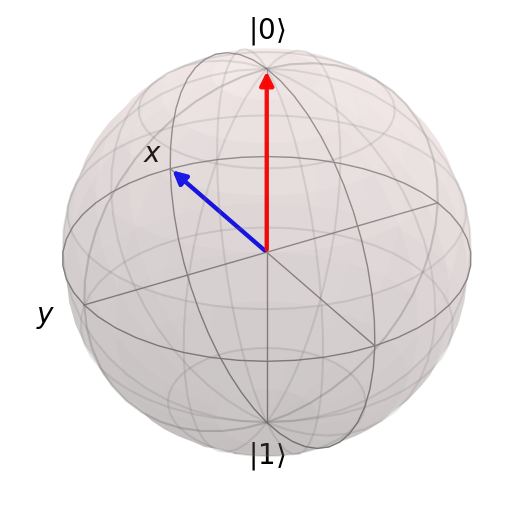
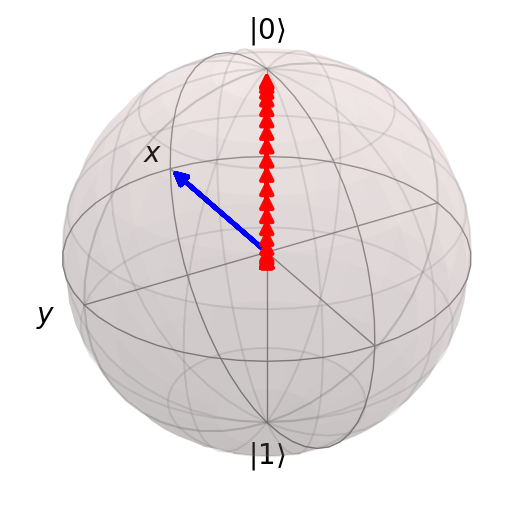
Example 6: CNOT gate (control qubit 0, target qubit 1)#
# Example 6: CNOT gate (control qubit 0, target qubit 1)
atoms = [(0.5, 0), (0, 0.5)]
circuit = NeutralAtomCircuit(atoms)
# CNOT = (I ⊗ H) CZ (I ⊗ H):
circuit.h(1)
circuit.cz(0, 1)
circuit.h(1)
result = circuit.run("10", step_rate=20)
# Show one Bloch sphere with initial and final states and
print("Duration of circuit (t):", circuit.t)
print("Number of pulses:", len(circuit.pulses))
computational_basis_blochs([result.states[0], result.states[-1]], "rb")
computational_basis_blochs(result.states, "rb")
Duration of circuit (t): 7
Number of pulses: 7
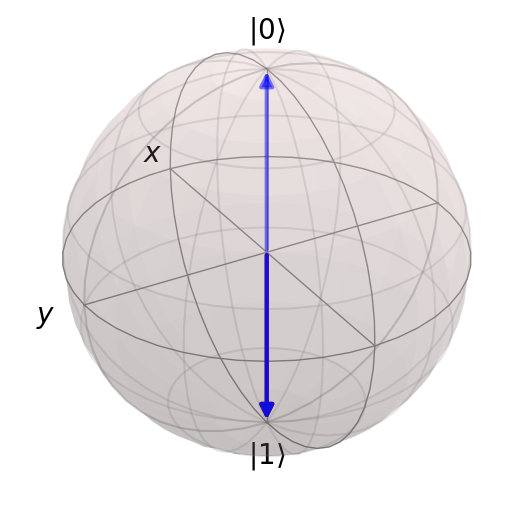
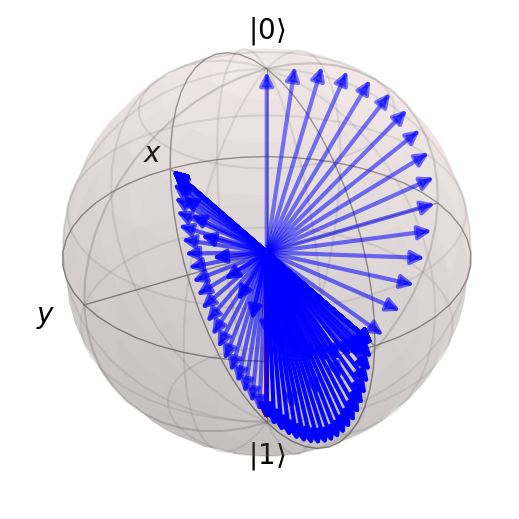
Example 7: Prepare a Bell state#
# Example 7: Prepare a Bell state
atoms = [(0.5, 0), (0, 0.5)]
circuit = NeutralAtomCircuit(atoms)
circuit.h(0)
circuit.cnot(0, 1)
result = circuit.run("00", step_rate=20)
# Show one Bloch sphere with initial and final states and
print("Duration of circuit (t):", circuit.t)
print("Number of pulses:", len(circuit.pulses))
computational_basis_blochs([result.states[0], result.states[-1]], "rb")
computational_basis_blochs(result.states, "rb")
Duration of circuit (t): 9
Number of pulses: 9
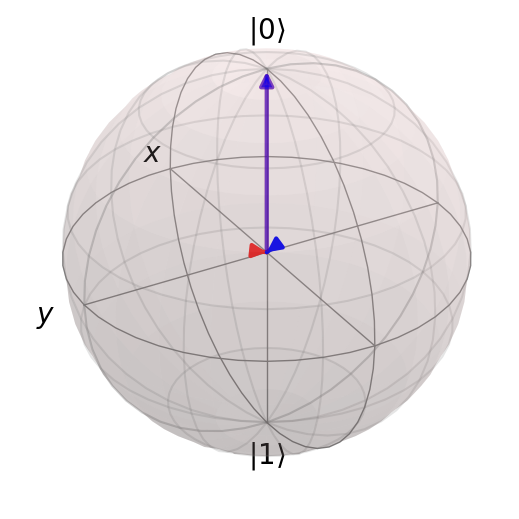
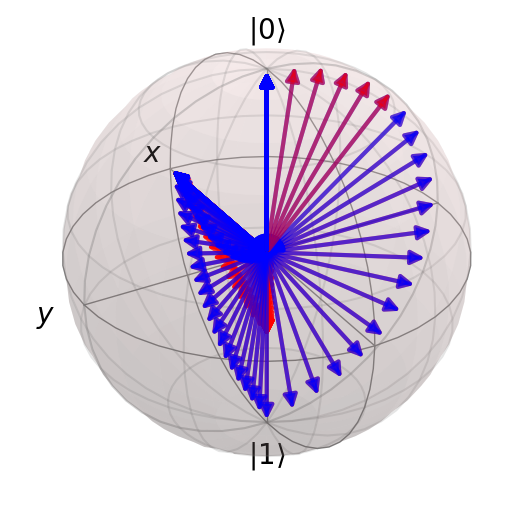
The fully entangled state appears as two completely mixed states that are represented by the arrow heads at the centre of the Bloch sphere. Let’s check that the final state really is the expected Bell state and not some other state that has the same reduced density matrix probabilities but a different relative phase.
Note: We use .tidyup(atol=1e-3) to hide the small but non-zero coefficients. This makes it easier to see the large coefficients, but you should also look at the coefficients without .tidyup to see what magnitude they are. The atol=1e-3 hides all coefficients less than 1e-3.
To understand what the coefficients on the final state mean, remember that the first coefficient is for the basis state |aa>, the second for |ab>, the third for |ar>, and then remainder for |ba>, |bb>, |br>, |ra>, |rb> and |rr>, in order.
The Bell state is |aa> + |bb> so we expect the first and fifth coefficients to be \(\frac{1}{\sqrt{2}}\) and the remaining coefficients to be small.
result.states[-1].copy().tidyup(atol=1e-3)
And here are the reduce density matrices for the two qubits:
result.states[-1].ptrace(0).tidyup(atol=1e-3)
result.states[-1].ptrace(1).tidyup(atol=1e-3)
Without the .tidyup applied, you can see all the smalller entries in the resulting state. These come from small numerical errors in determining the evolution of the system:
result.states[-1]

